Numerical Modeling of Erosion in Hall Effect Thrusters
Abstract
1. Introduction
- The threshold energy, Eth (i.e., the minimum energy of an incident particle to allow sputtering to start), is used as fitting parameter with respect to experiments;
- The effect of wall temperature on sputtering [12] has never been taken into account;
- The most recent sputtering data regarding the Xe–Borosil couple by Ranjan et al. [13] has never been considered.
2. Erosion Model
2.1. Plasma Simulation: HYPICFLU2
HYPICFLU2 Validation
2.2. Sputtering Modeling
- Method 3: An interpolation using UnivariateSpline, a built-in function in Python, which interpolates data by Ranjan et al. [13] for a given angle (all the energies) and then extrapolates to the point of interest, in particular the energy at which the sputter yield nullifies. In our case, a spline of the fourth degree was considered.
- The effect of temperature at different energies is unknown, and changing the gradient would imply making assumptions on such an effect. Also, Ranjan’s data [13] at room temperature is the only widespread data on which it is possible to rely;
- Maintaining the same gradient for the extrapolation below 100 eV implicates a reduction in the minimum energy at which sputtering first occurs as temperature increases. As temperature increases, the bond strength may decrease, allowing for atoms to be sputtered from the surface at lower energies. This is yet another assumption but, given the uncertain value assigned to it in past models, it seemed a reasonable one.
- The set of sputter yield points at various angles and energy by Ranjan et al. [13] is multiplied by the temperature coefficient (), obtaining a new set of points with higher sputter yield values.
- From the new value of sputter yield at 100 eV, incremented by , a value of the threshold energy for any given angle is extrapolated following the average gradient of the sputter yield value of Ranjan’s data (without the temperature coefficient—Method 1). This leads to a decrease in threshold energy for an increase in temperature coefficient; hence, simulated surface temperature.
- Added to the set of points are the values of sputter yield at 90° of incidence angle, which is 0 for all energies.
3. Results
4. Discussion
Author Contributions
Funding
Data Availability Statement
Acknowledgments
Conflicts of Interest
Abbreviations
| Symbols | |
| Boltzmann constant | |
| e | Electron charge |
| Ion mass | |
| Erosion rate | |
| Ions incidence angle | |
| Eth | Threshold energy |
| E | Ion impacting energy |
| v | Ion velocity |
| Y | Sputtering yield |
| Temperature coefficient | |
| t | time |
| r | Radial coordinate |
| z | Axial coordinate |
| n | Particle number density |
| Electron temperature | |
| Potential | |
| Thermalized potential | |
| current density vector | |
| V | Volume/voltage |
| Flux of electrons | |
| SEE yield | |
| q | Energy flux to the wall |
| Discharge current | |
| Discharge power | |
| Ion discharge velocity | |
| Mass flow rate | |
| Specific impulse | |
| T | Thrust |
| Efficiency | |
| Subscripts | |
| i | Ion |
| e | Electron |
| n | Neutral |
| w | Wall |
| Electron-ion | |
| Electron-neutral | |
| b | Bohm |
| Abbreviations | |
| GEO | Geostationary Earth orbit |
| LEO | Low Earth orbit |
| HET(s) | Hall effect thruster(s) |
| SPT | Stationary plasma thruster |
| PIC | Particle in cell |
| HYPICFLU | HYbrid PIC-FLUid |
| SEE | Secondary electron emission |
| CSR | Charge saturation regime |
| CSL | Charge saturation limit |
| BN | Boron nitride |
| Borosil | |
| IFDM | Irregular-grid finite difference method |
| CW | Correct weighting |
| VW | Volume weighting |
| BF | Bohm criterion forcing |
| Xe/ | Xenon/ions |
| LIF | Laser-induced fluorescence |
| TS | Thermal Spike |
Appendix A. Review of Sputtering-Yield Models
References
- Lev, D.; Myers, R.M.; Lemmer, K.M.; Kolbeck, J.; Koizumi, H.; Polzin, K. The technological and commercial expansion of electric propulsion. Acta Astronaut. 2019, 159, 213–227. [Google Scholar] [CrossRef]
- NASA. Ion Propulsion System. 2018. Available online: https://solarsystem.nasa.gov/missions/dawn/technology/ion-propulsion/ (accessed on 13 March 2023).
- Gamero-Castano, M.; Katz, I. Estimation of Hall Thruster Erosion Using HPHall. In Proceedings of the 29th International Electric Propulsion Conference, Princeton, NJ, USA, 31 October– 21 November 2005. [Google Scholar]
- Hofer, R.; Mikellides, I.; Katz, I.; Goebel, D. Wall Sheath and Electron Mobility Modeling in Hybrid-PIC Hall Thruster Simulations. In Proceedings of the 43rd AIAA/ASME/SAE/ASEE Joint Propulsion Conference & Exhibit, Cincinnati, OH, USA, 8–11 July 2007. [Google Scholar] [CrossRef]
- Ahedo, E. Plasmas for space propulsion. Plasma Phys. Control. Fusion 2011, 53, 124037. [Google Scholar] [CrossRef]
- Boeuf, J.P. Tutorial: Physics and modeling of Hall thrusters. J. Appl. Phys. 2017, 121, 011101. [Google Scholar] [CrossRef]
- Garrigues, L.; Hagelaar, G.J.M.; Bareilles, J.; Boniface, C.; Boeuf, J.P. Model study of the influence of the magnetic field configuration on the performance and lifetime of a Hall thruster. Phys. Plasmas 2003, 10, 4886–4892. [Google Scholar] [CrossRef]
- Manzella, D.; Yim, J.; Boyd, I. Predicting Hall Thruster Operational Lifetime. In Proceedings of the 40th AIAA/ASME/SAE/ASEE Joint Propulsion Conference and Exhibit, Fort Lauderdale, FL, USA, 11–14 July 2004. [Google Scholar] [CrossRef]
- Ahedo, E.; Antón, A.; Garmendia, I.; Caro, I.; del Amo, J.G. Simulation of wall erosion in Hall thrusters. In Proceedings of the International Electric Propulsion Conference, Florence, Italy, 17–20 September 2007. [Google Scholar]
- Cheng, S.Y.; Martinez-Sanchez, M. Hybrid Particle-in-Cell Erosion Modeling of Two Hall Thrusters. J. Propuls. Power 2008, 24, 987–998. [Google Scholar] [CrossRef]
- Giannetti, V.; Leporini, A.; Andreussi, T.; Andrenucci, M. Theoretical Investigation of a 5 kW Class Hall Effect Thruster. In Proceedings of the 34th International Electric Propulsion Conference, Kobe-Hyogo, Japan, 4–10 July 2015. [Google Scholar]
- Parida, B.K.; Sooraj, K.P.; Hans, S.; Pachchigar, V.; Augustine, S.; Remyamol, T.; Ajith, M.R.; Ranjan, M. Sputtering yield and nanopattern formation study of BNSiO2 (Borosil) at elevated temperature relevance to Hall Effect Thruster. Nucl. Instruments Methods Phys. Res. 2022, 514, 1–7. [Google Scholar] [CrossRef]
- Ranjan, M.; Sharma, A.; Vaid, A.; Bhatt, V.N.T.; James, M.G.; Revathi, H.; Mukherjee, S. BN/BNSiO2 sputtering yield shape profiles under stationary plasma thruster operating conditions. AIP Adv. 2016, 6, 095224. [Google Scholar] [CrossRef]
- Hofer, R.; Katz, I.; Mikellides, I.; Gamero-Castano, M. Heavy Particle Velocity and Electron Mobility Modeling in Hybrid-PIC Hall Thruster Simulations. In Proceedings of the 42nd AIAA/ASME/SAE/ASEE Joint Propulsion Conference & Exhibit, Sacramento, CA, USA, 9–12 July 2006. [Google Scholar] [CrossRef]
- Koo, J.W. Hybrid PIC-MCC Computational Modeling of Hall Thrusters. Ph.D. Thesis, The University of Michigan, Ann Arbor, MI, USA, 2005. [Google Scholar]
- Kawashima, R.; Komurasaki, K.; Schonherr, T.; Koizumi, H. Hybrid Modeling of a Hall Thruster Using Hyperbolic System of Electron Conservation Laws. In Proceedings of the 34th International Electric Propulsion Conference, Hyogo-Kobe, Japan, 4–10 July 2015. [Google Scholar]
- MacDonald-Tenenbaum, N.; Pratt, Q.; Nakles, M.; Pilgram, N.; Holmes, M.; Hargus, W. Background Pressure Effects on Ion Velocity Distributions in an SPT-100 Hall Thruster. J. Propuls. Power 2019, 35, 403–412. [Google Scholar] [CrossRef]
- Tskhakaya, D. The Particle-in-Cell Method. In Computational Many-Particle Physics; Fehske, H., Schneider, R., Weiße, A., Eds.; Springer: Berlin/Heidelberg, Germany, 2008; pp. 161–189. [Google Scholar] [CrossRef]
- Panelli, M.; Morfei, D.; Milo, B.; D’Aniello, F.A.; Battista, F. Axisymmetric Hybrid Plasma Model for Hall Effect Thrusters. Particles 2021, 4, 296–324. [Google Scholar] [CrossRef]
- Fife, J.M. Two-Dimensional Hybrid Particle-in-Cell Modelling of Hall Thrusters. Master’s Thesis, Massachusetts Institute of Technologies, Department of Aeronautics and Astronautics, Cambridge, MA, USA, 1995. [Google Scholar]
- Fife, J.M. Hybrid-PIC Modelling and Electrostatic Probe Survey of Hall Thrusters. Ph.D. Thesis, Massachusetts Institute of Technologies, Cambridge, MA, USA, 1999. [Google Scholar]
- Petronelli, A.; Panelli, M.; Battista, F. Particle-In-Cell Simulation of Heavy Species in Hall Effect Discharge. Aerotec. Missili Spaz. 2022, 101, 143–157. [Google Scholar] [CrossRef]
- Parra, F.I.; Ahedo, E.; Fife, J.M.; Martínez-Sánchez, M. A two-dimensional hybrid model of the Hall thruster discharge. J. Appl. Phys. 2006, 100, 023304. [Google Scholar] [CrossRef]
- Xu, G. Development of Irregular-Grid Finite Difference Method ( IFDM ) for Governing Equations in Strong Form. WSEAS Trans. Math. 2006, 5, 1117. [Google Scholar]
- Jolivet, L.; Roussel, J.F. Numerical modeling of plasma sheath phenomena in the presence of secondary electron emission. IEEE Trans. Plasma Sci. 2002, 30, 318–326. [Google Scholar] [CrossRef]
- Parra, F.I.; Ahedo, E.; Martinez-Sanchex, M.; Fife, M. Improvement of the Plasma-Wall Model on a Fluid-PIC Code of a Hall Thruster. In Proceedings of the 4th International Spacecraft Propulsion Conference, Sardinia, Italy, 2–4 June 2004; Wilson, A., Ed.; ESA Special Publication; ESA: Paris, France, 2004; Volume 555, p. 104.1. [Google Scholar]
- Lopedote, E.; Panelli, M.; Battista, F. Scaling of Magnetic Circuit for Magnetically Shielded Hall Effect Thrusters. Aerotec. Missili Spaz. 2023, 102, 109–125. [Google Scholar] [CrossRef]
- Goebel, D.; Katz, I. Fundamentals of Electric Propulsion Ion and Hall Thrusters; JPL Space Science and Technology Series; California Institute of Technology: Pasadena, CA, USA, 2008. [Google Scholar]
- Kwon, K. A Novel Numerical Analysis of Hall Effect Thruster and Its Application in Simultaneous Design of Thruster and Optimal Low-Thrust Trajectory. Ph.D. Thesis, Georgia Institute of Technology, Atlanta, GA, USA, 2010. [Google Scholar]
- Ahedo, E.; Santos, R.; Parra, F.I. Fulfillment of the kinetic Bohm criterion in a quasineutral particle-in-cell model. Phys. Plasmas 2010, 17, 073507. [Google Scholar] [CrossRef]
- Escobar, D.; Ahedo, E.; Parra, F.I. On conditions at the sheath boundaries of a quasineutral code for Hall thrusters. In Proceedings of the 29 th International Electric Propulsion Conference, Princeton, NJ, USA, 31 October–21 November 2005. [Google Scholar]
- Garnier, Y.; Viel, V.; Roussel, J.F.; Bernard, J. Low-energy xenon ion sputtering of ceramics investigated for stationary plasma thrusters. J. Vac. Sci. Technol. A 1999, 17, 3246–3254. [Google Scholar] [CrossRef]
- Kim, V.; Kozlov, V.; Semenov, A.; Shkarban, I. Investigation of the Boron Nitride based Ceramics Sputtering Yield Under it’s Bombardment by Xe and Kr ions. In Proceedings of the 27th International Electric Propulsion Conference, Pasadena, CA, USA, 15–19 October 2001; Available online: https://api.semanticscholar.org/CorpusID:115151109 (accessed on 25 January 2024).
- Alfeld, P. A bivariate C2 Clough-Tocher scheme. Comput. Aided Geom. Des. 1984, 1, 257–267. [Google Scholar] [CrossRef]
- Myers, J.; Kamhawi, H.; Yim, J.; Clayman, L. Hall Thruster Thermal Modeling and Test Data Correlation. In Proceedings of the American Institute of Aeronautics and Astronautics, Propulsion and Energy Conference, National Harbor, MD, USA, 25–27 July 2016. [Google Scholar]
- Kamhawi, H.; Liu, T.M.; Benavides, G.F.; Mackey, J.; Server-Verhey, T.; Yim, J.; Butler-Craig, N.I.; Myers, J. Performance, Stability, and Thermal Characterization of a Sub-Kilowatt Hall Thruster. In Proceedings of the 36th International Electric Propulsion Conference, Vienna, Austria, 15–20 September 2019. [Google Scholar]
- Absalamov, S.K.; Andreev, V.B.; Colbert, T.S.; Day, M.; Egorov, V.V.; Gnizdor, U.R.; Kaufman, H.; Kim, V.; Korakin, I.A.; Kozubsky, K.; et al. Measurement of Plasma Parameters in the Stationary Plasma Thruster (SPT-100) Plume and its Effect on Spacecraft Components. In Proceedings of the 28th Joint Propulsion Conference and Exhibit, Nashville, TN, USA, 6–8 July 1992. [Google Scholar] [CrossRef]
- Garnier, Y.; Viel, V.; Roussel, J.F.; Pagnon, D.; Magne, L.; Touzeau, M. Investigation of Xenon ion sputtering of one ceramic material used in SPT discharge chamber. In Proceedings of the 26th International Electric Propulsion Conference, Kitakyushu, Japan, 17–21 October 1999. [Google Scholar]
- Roy, S.; Pandey, B.P. Plasma–wall interaction inside a Hall thruster. J. Plasma Phys. 2002, 68, 305–319. [Google Scholar] [CrossRef]
- Yamamura, Y.; Tawara, H. Energy Dependence of Ion-Induced Sputtering Yields from Monoatomic Solids at Normal Incidence; Technical Report NIFS-DATA-23; National Institute for Fusion Science: Heliotron, Japan, 1995. [Google Scholar] [CrossRef]
- Hofer, R.R.; Mikellides, I.G.; Katz, I.; Goebel, D.M. BPT-4000 Hall Thruster Discharge Chamber Erosion Model Comparison with Qualification Life Test Data. In Proceedings of the 30th International Electric Propulsion Conference, Florence, Italy, 17–20 September 2007; Available online: https://api.semanticscholar.org/CorpusID:113891855 (accessed on 25 January 2024).
- Cho, S.; Yokota, S.; Kaneko, R.; Komurasaki, K.; Arakawa, Y. Channel Wall Erosion Modeling of a SPT-Type Hall Thruster. Trans. Jpn. Soc. Aeronaut. Space Sci. Aerosp. Technol. Jpn. 2012, 10, Pb25–Pb30. [Google Scholar] [CrossRef] [PubMed]
- Vrebosch, T.M.F.; Misuri, T.; Andrenucci, M.; Zandbergen, B.T.C. Model for Predicting the Lifetime of a Hall Effect Thruster. In Proceedings of the Space propulsion 2012 Conference, Bordeaux, France, 7–10 May 2012. [Google Scholar]
- Schinder, A.M.; Walker, M.L.; Rimoli, J. 3D Model for Atomic Sputtering of Heterogeneous Ceramic Compounds. In Proceedings of the 49th AIAA/ASME/SAE/ASEE Joint Propulsion Conference, San Jose, CA, USA, 14–17 July 2013. [Google Scholar] [CrossRef]
- Perez-Grande, D.; Fajardo, P.; Ahedo, E. Evaluation of Erosion Reduction Mechanisms in Hall Effect Thrusters. In Proceedings of the Joint Conference of 30th ISTS, 34th IEPC and 6th NSAT, Kobe-Hyogo, Japan, 4–10 July 2015. [Google Scholar]

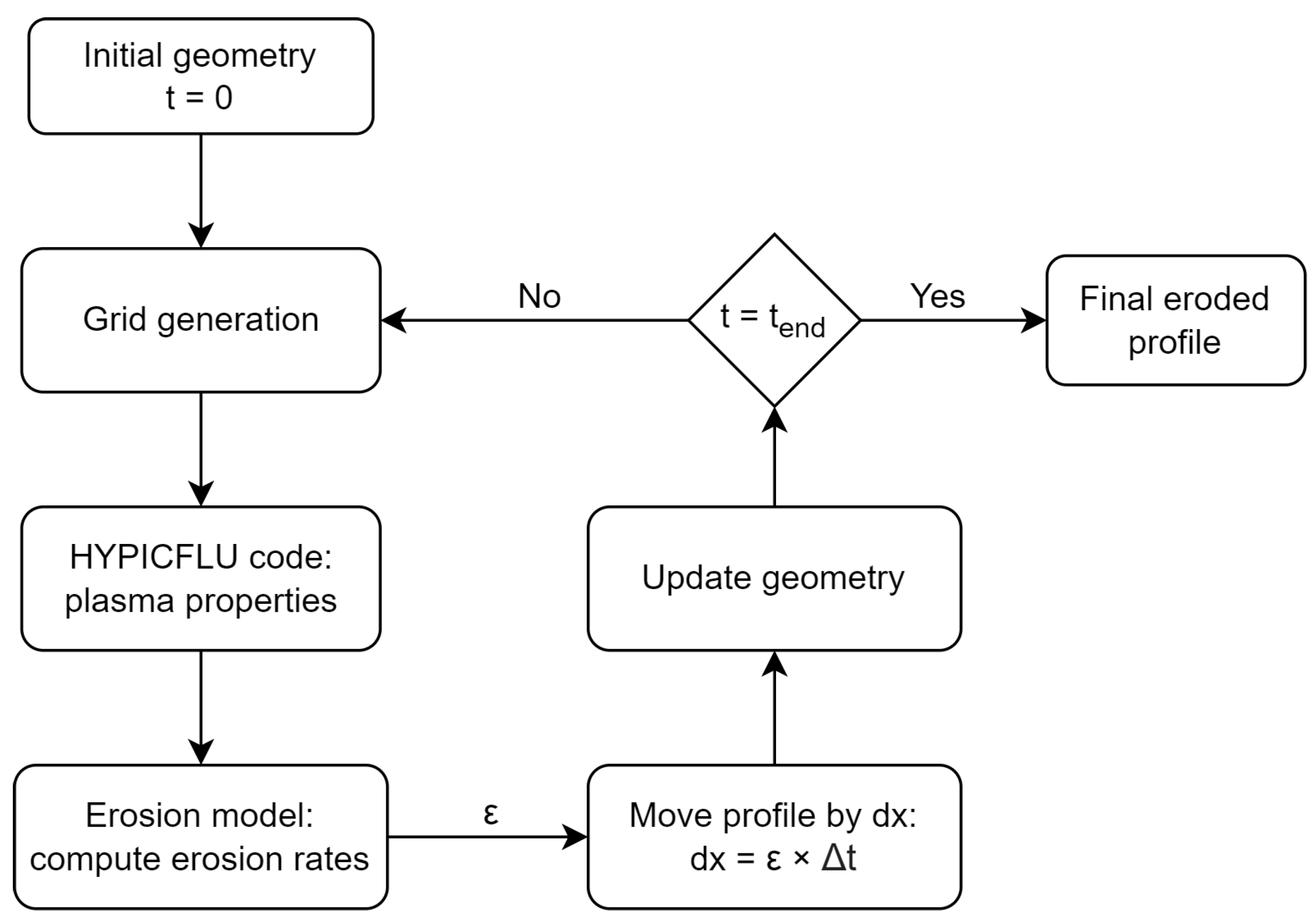
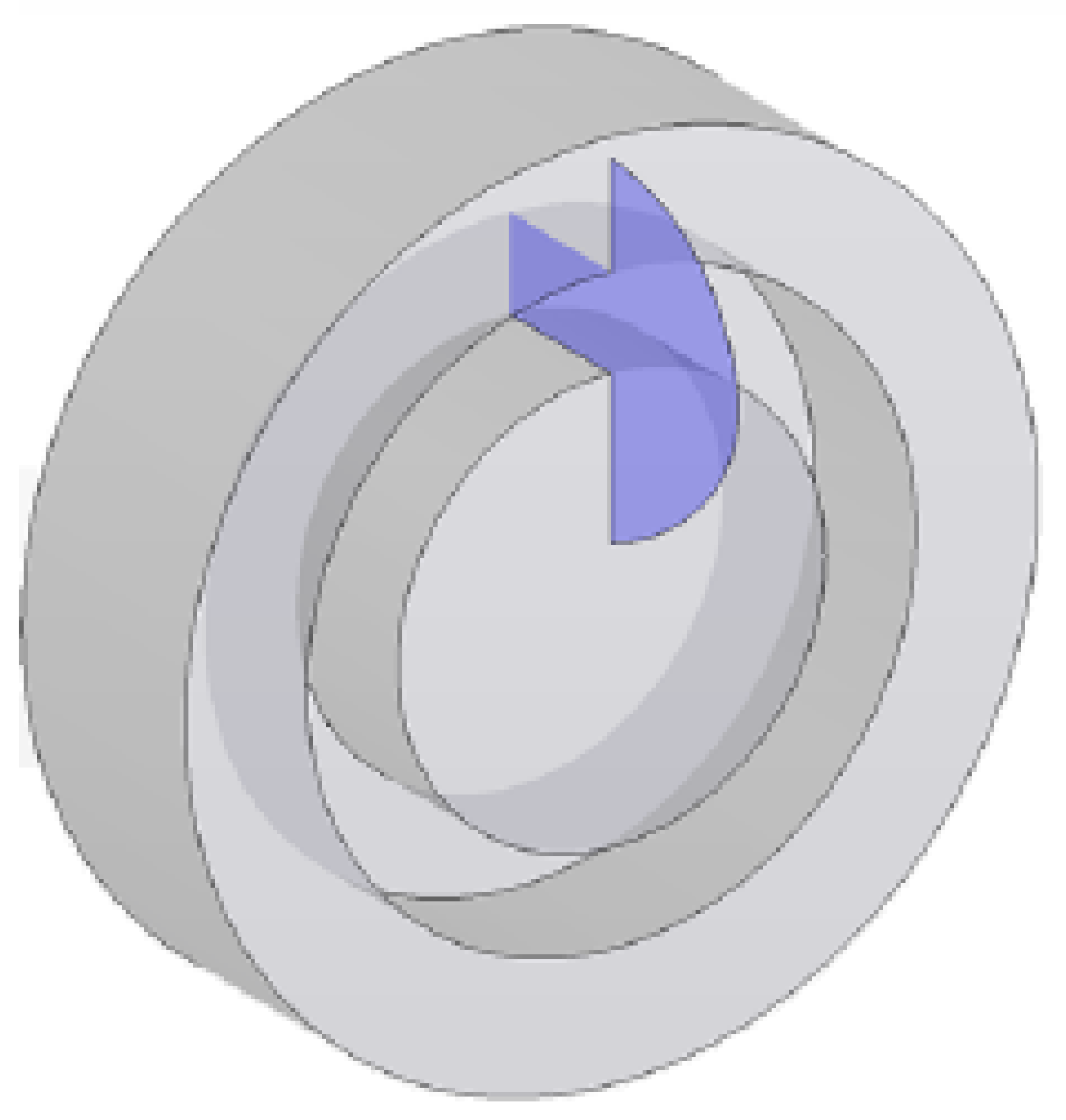
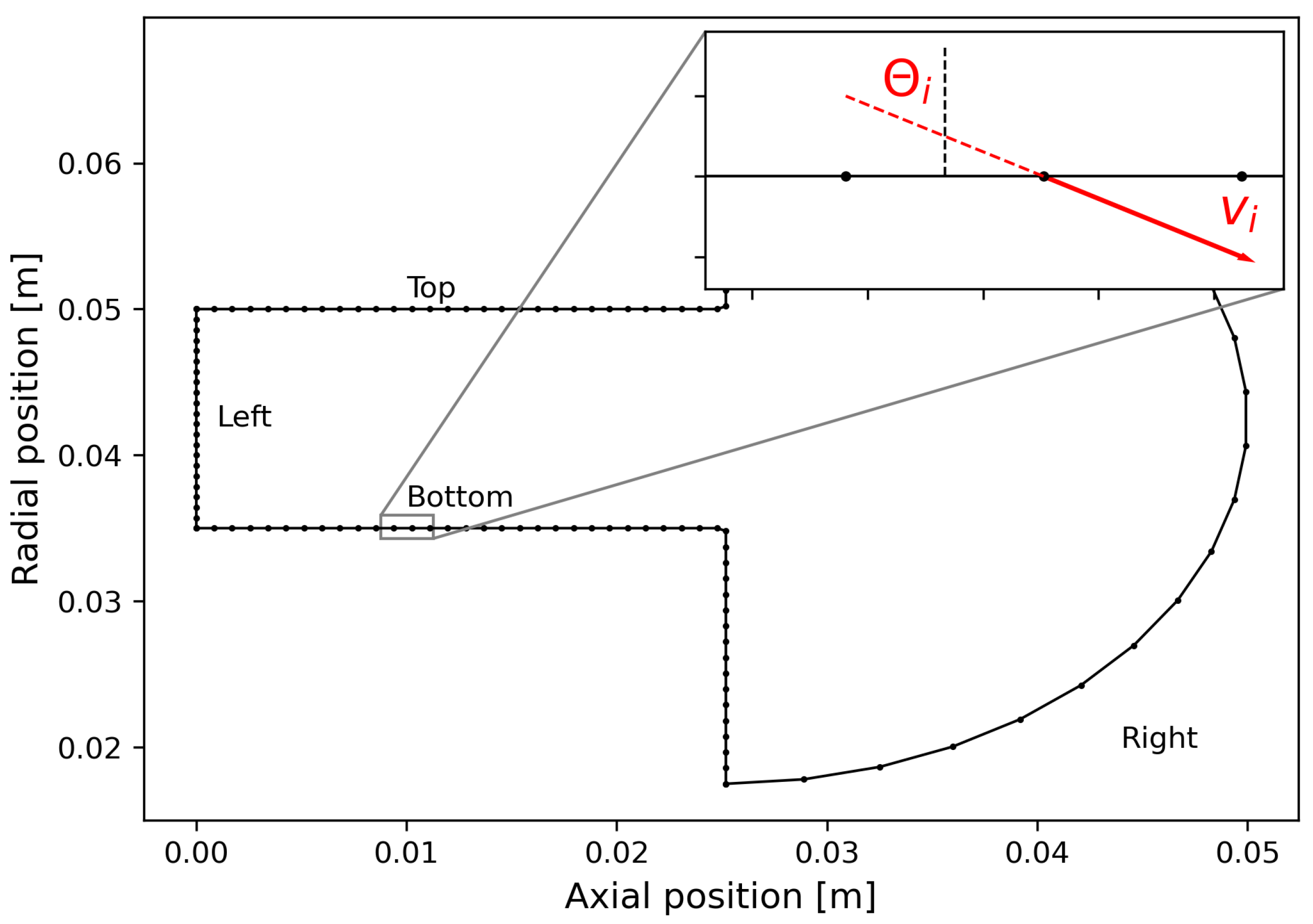

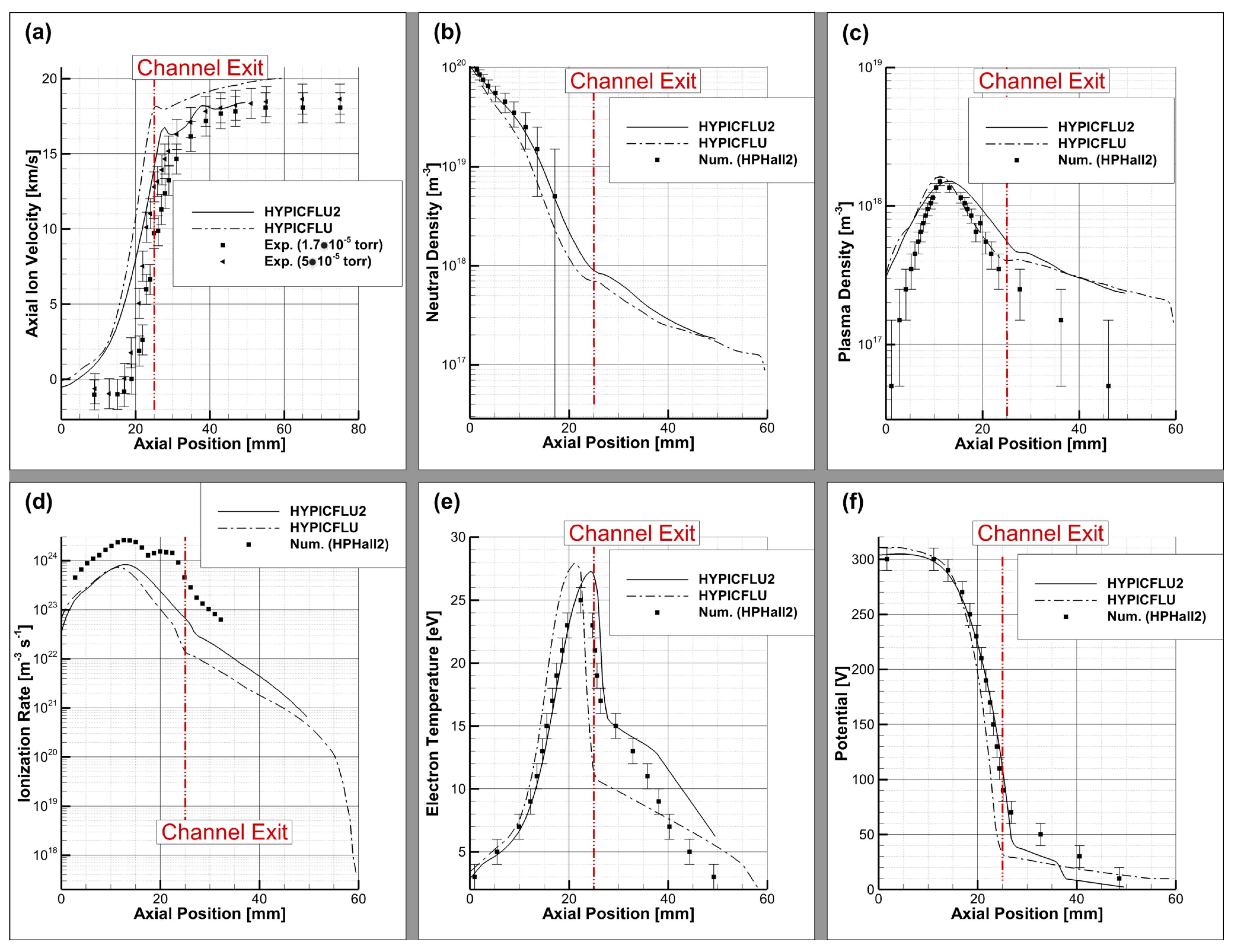
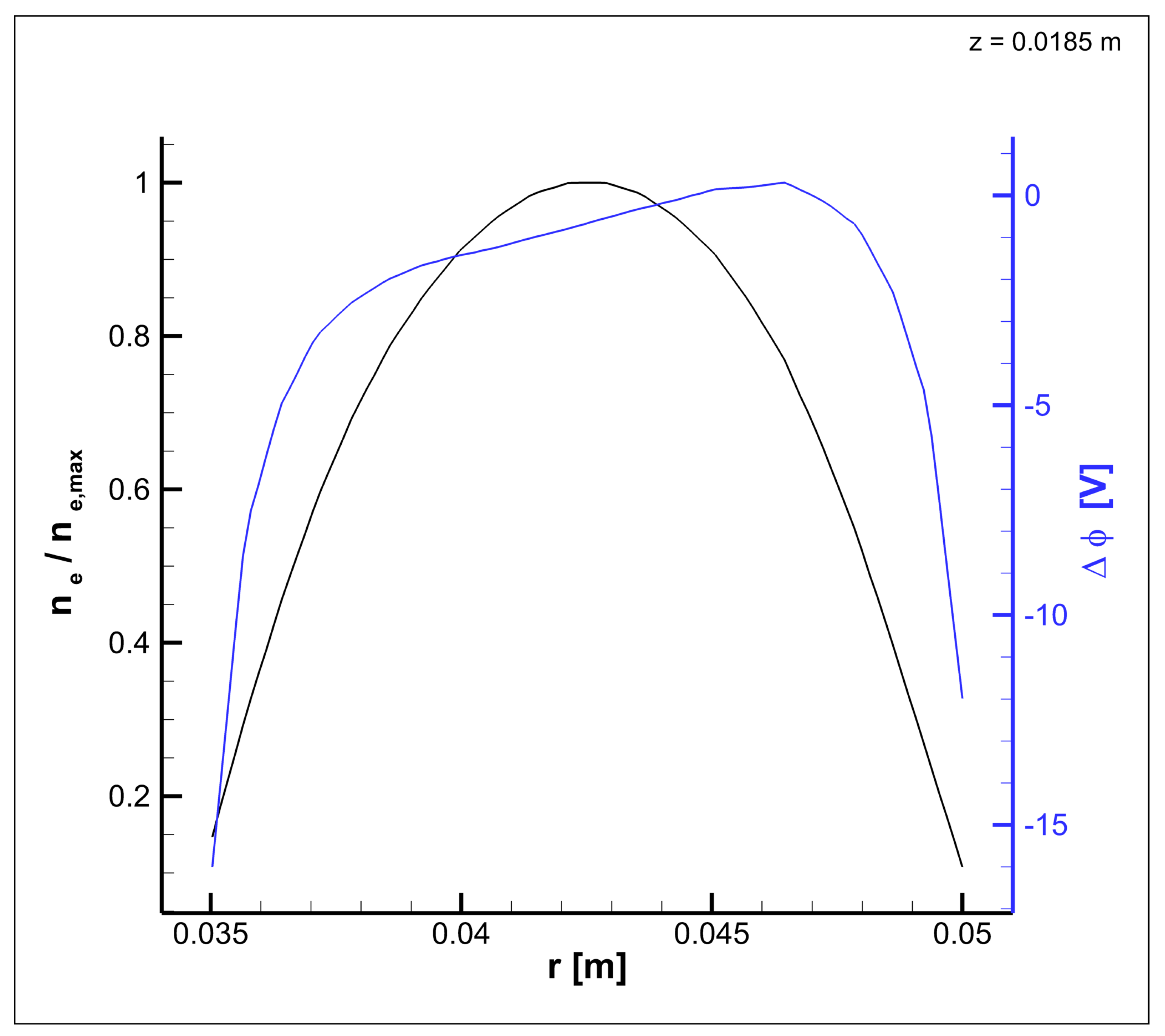
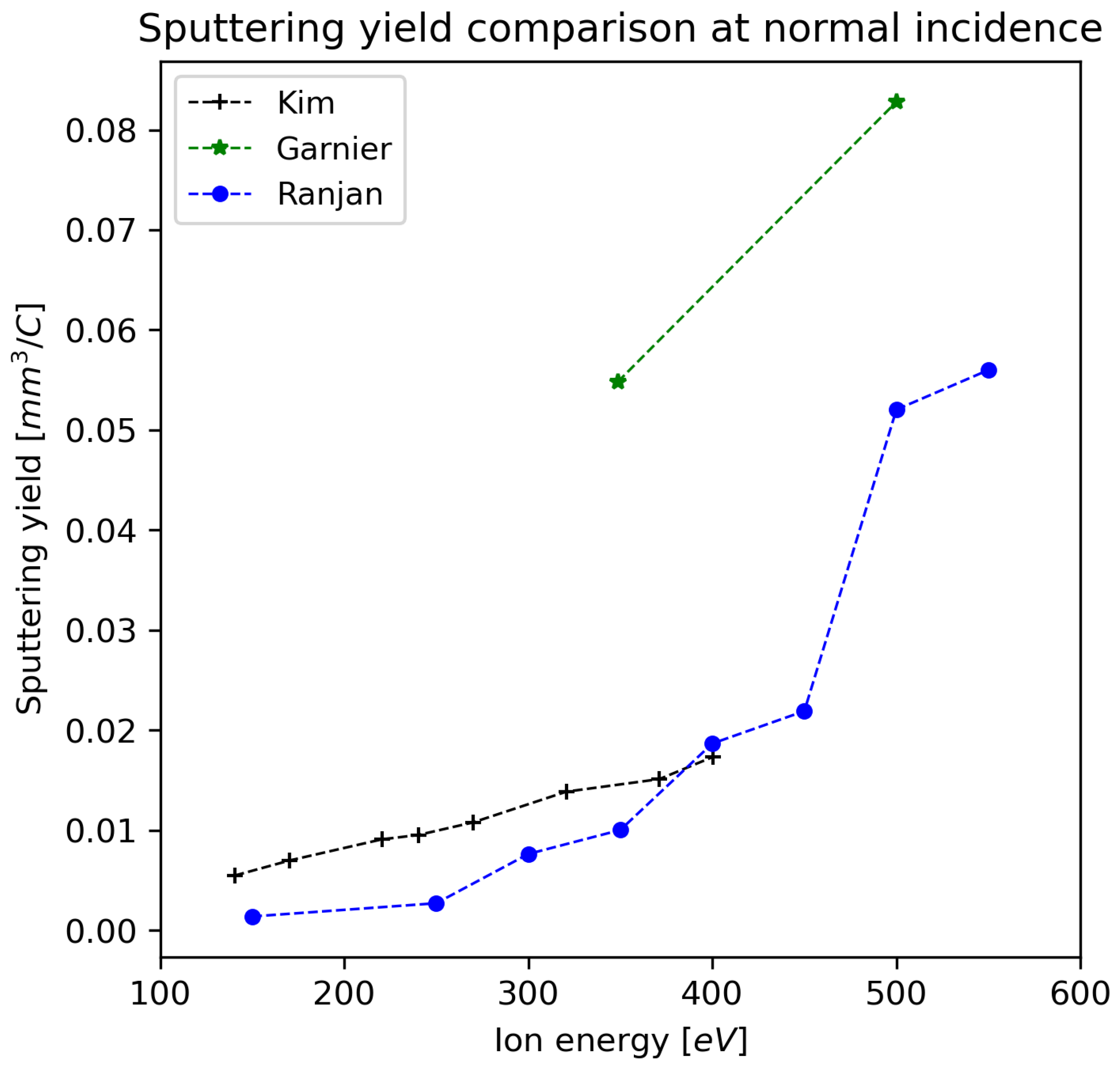


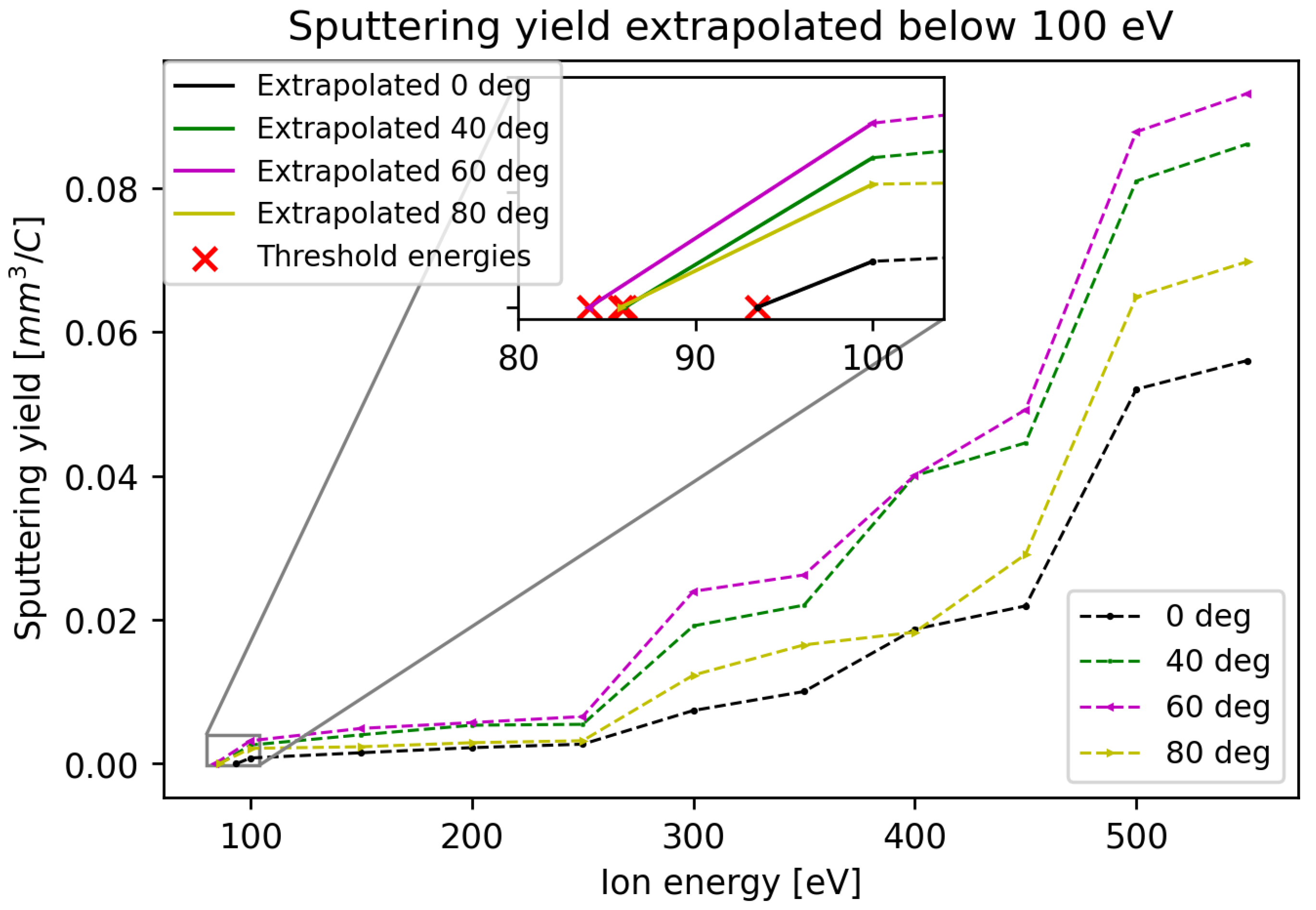

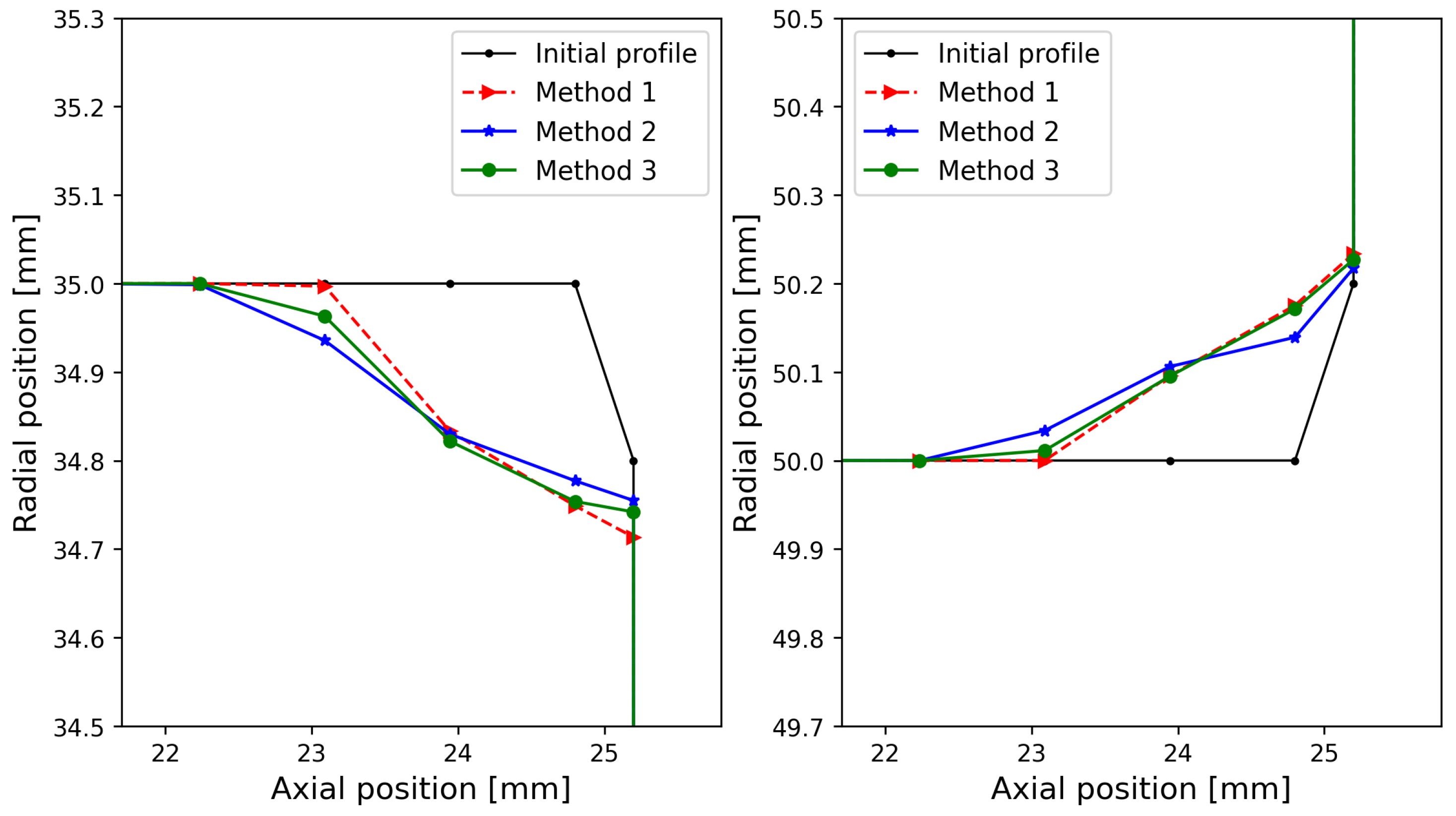
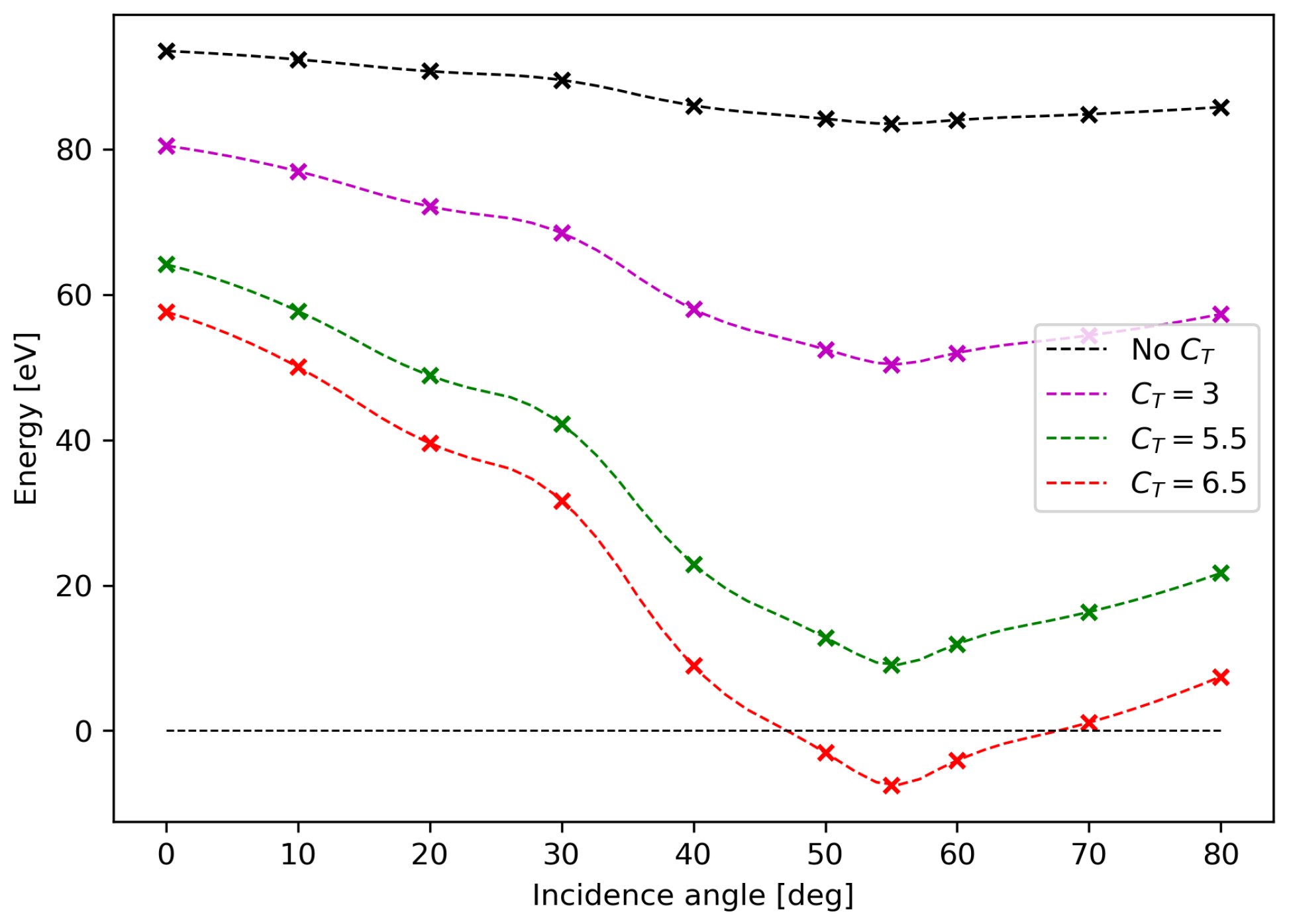
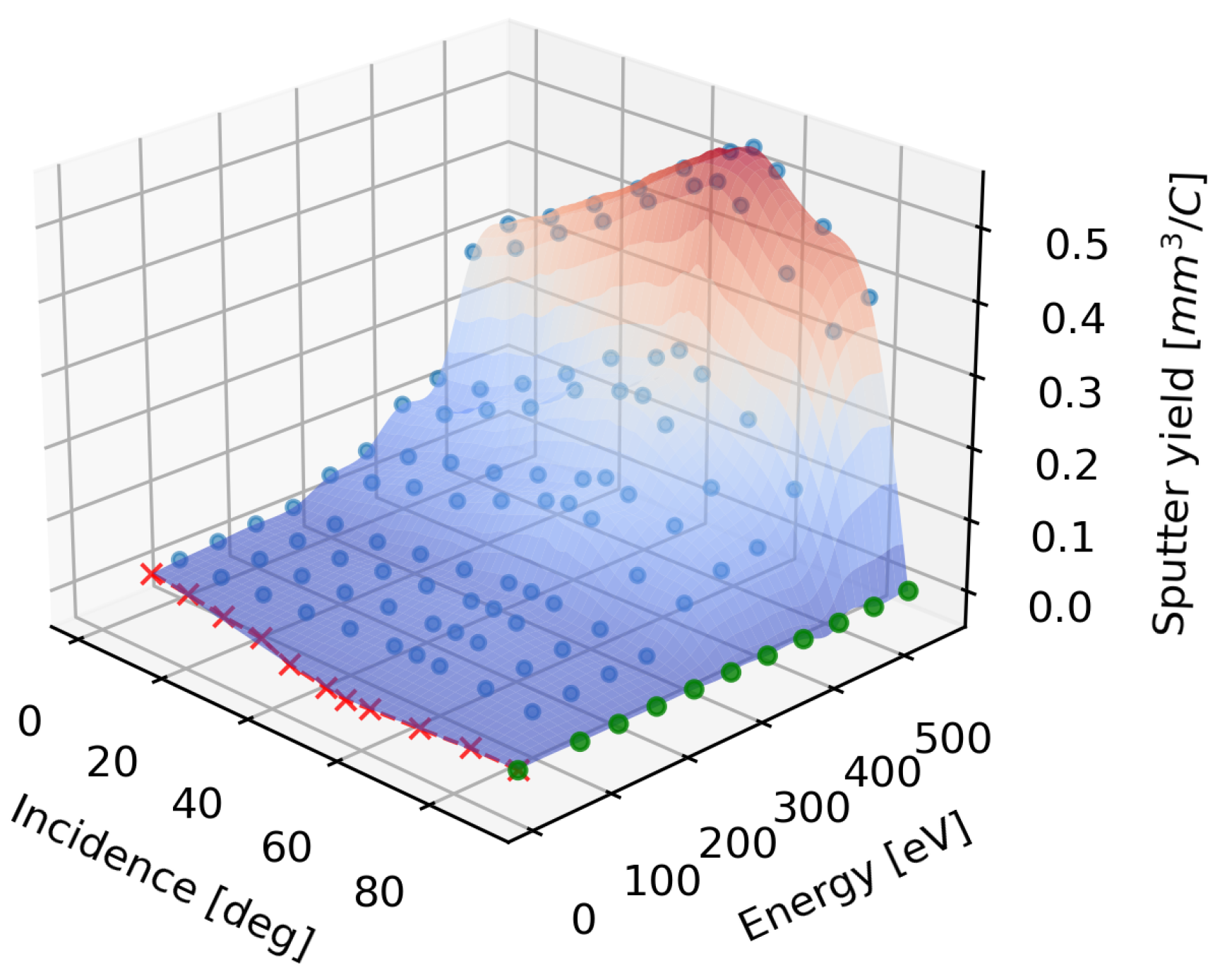
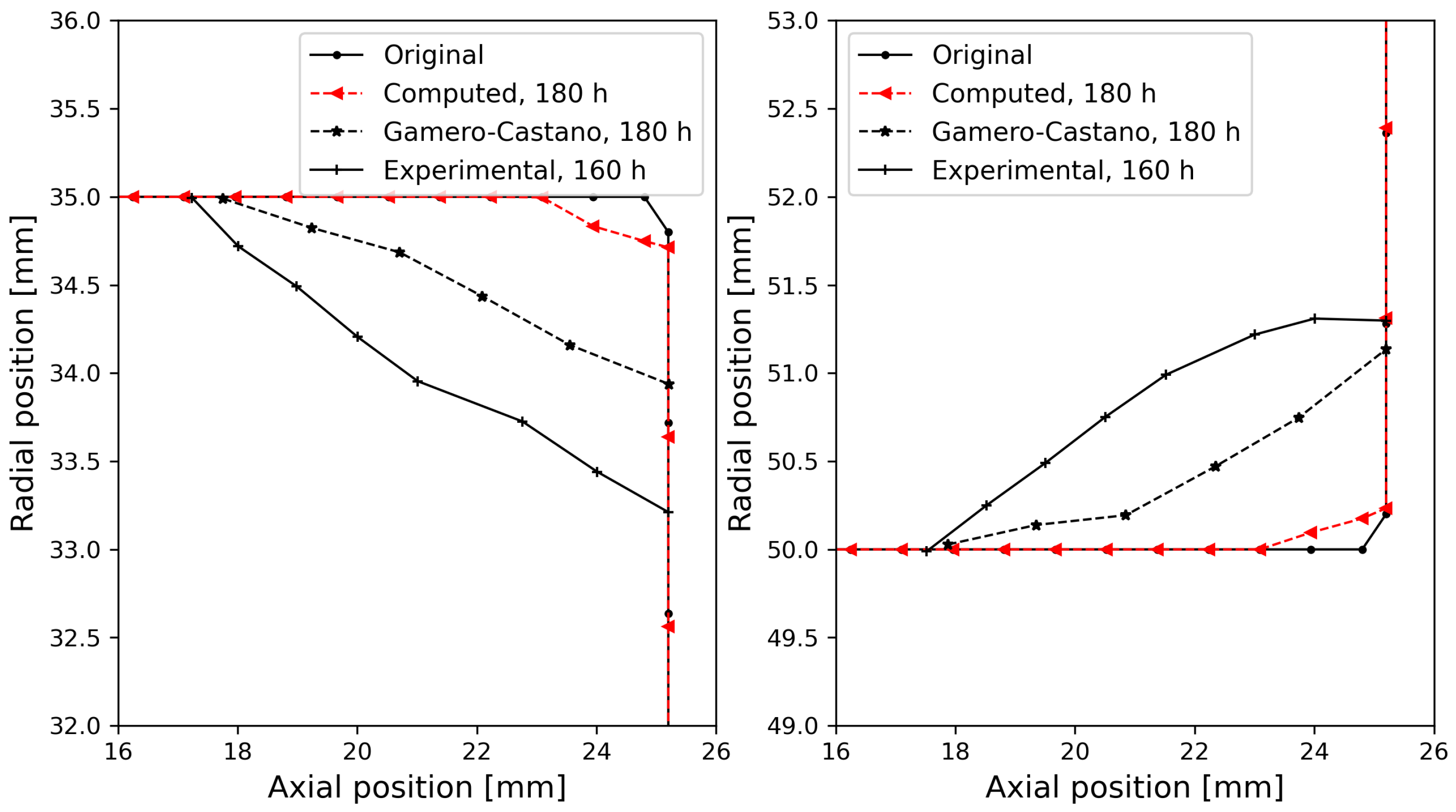

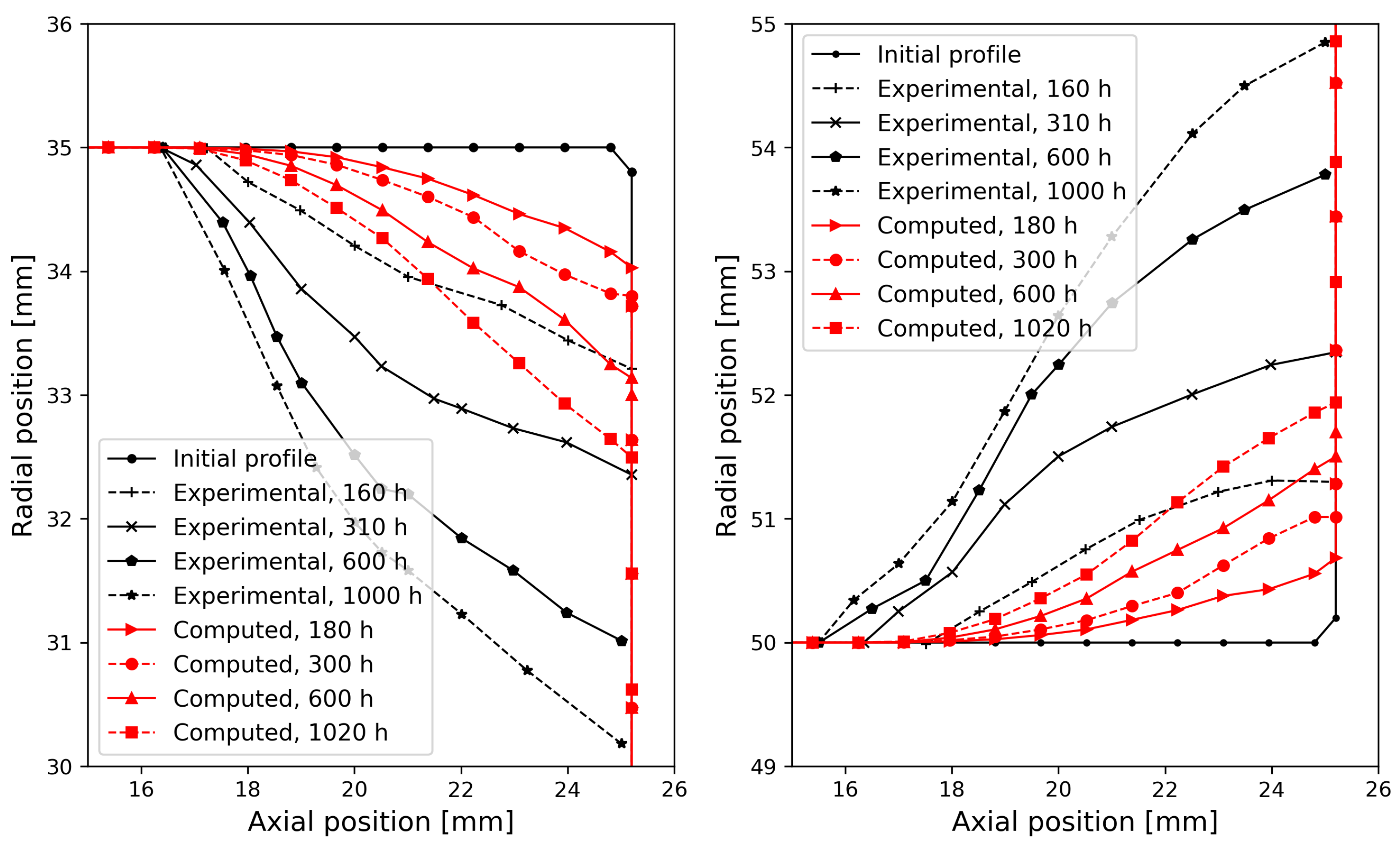

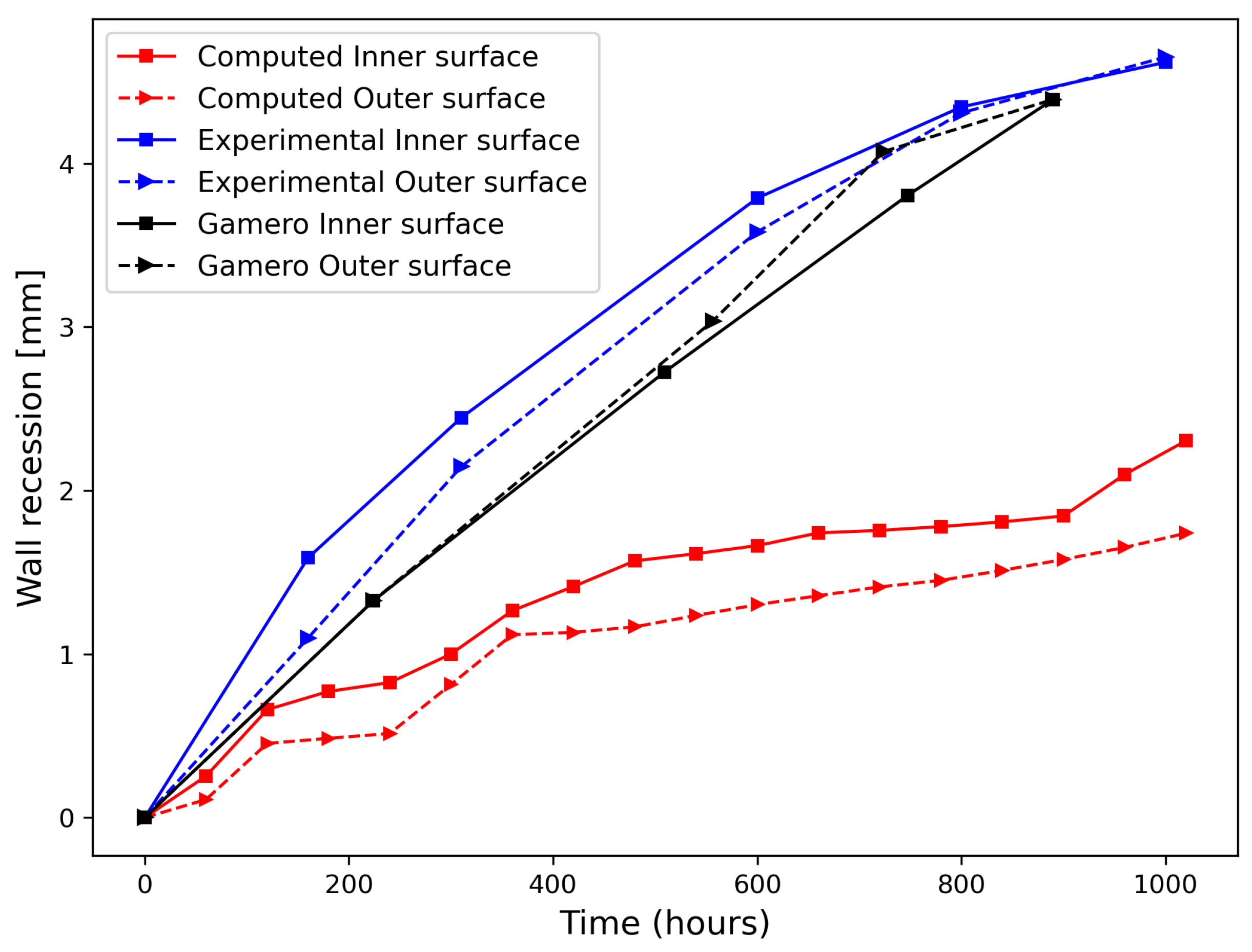
Disclaimer/Publisher’s Note: The statements, opinions and data contained in all publications are solely those of the individual author(s) and contributor(s) and not of MDPI and/or the editor(s). MDPI and/or the editor(s) disclaim responsibility for any injury to people or property resulting from any ideas, methods, instructions or products referred to in the content. |
© 2024 by the authors. Licensee MDPI, Basel, Switzerland. This article is an open access article distributed under the terms and conditions of the Creative Commons Attribution (CC BY) license (https://creativecommons.org/licenses/by/4.0/).
Share and Cite
Passet, M.; Panelli, M.; Battista, F. Numerical Modeling of Erosion in Hall Effect Thrusters. Particles 2024, 7, 121-143. https://doi.org/10.3390/particles7010007
Passet M, Panelli M, Battista F. Numerical Modeling of Erosion in Hall Effect Thrusters. Particles. 2024; 7(1):121-143. https://doi.org/10.3390/particles7010007
Chicago/Turabian StylePasset, Matteo, Mario Panelli, and Francesco Battista. 2024. "Numerical Modeling of Erosion in Hall Effect Thrusters" Particles 7, no. 1: 121-143. https://doi.org/10.3390/particles7010007
APA StylePasset, M., Panelli, M., & Battista, F. (2024). Numerical Modeling of Erosion in Hall Effect Thrusters. Particles, 7(1), 121-143. https://doi.org/10.3390/particles7010007








